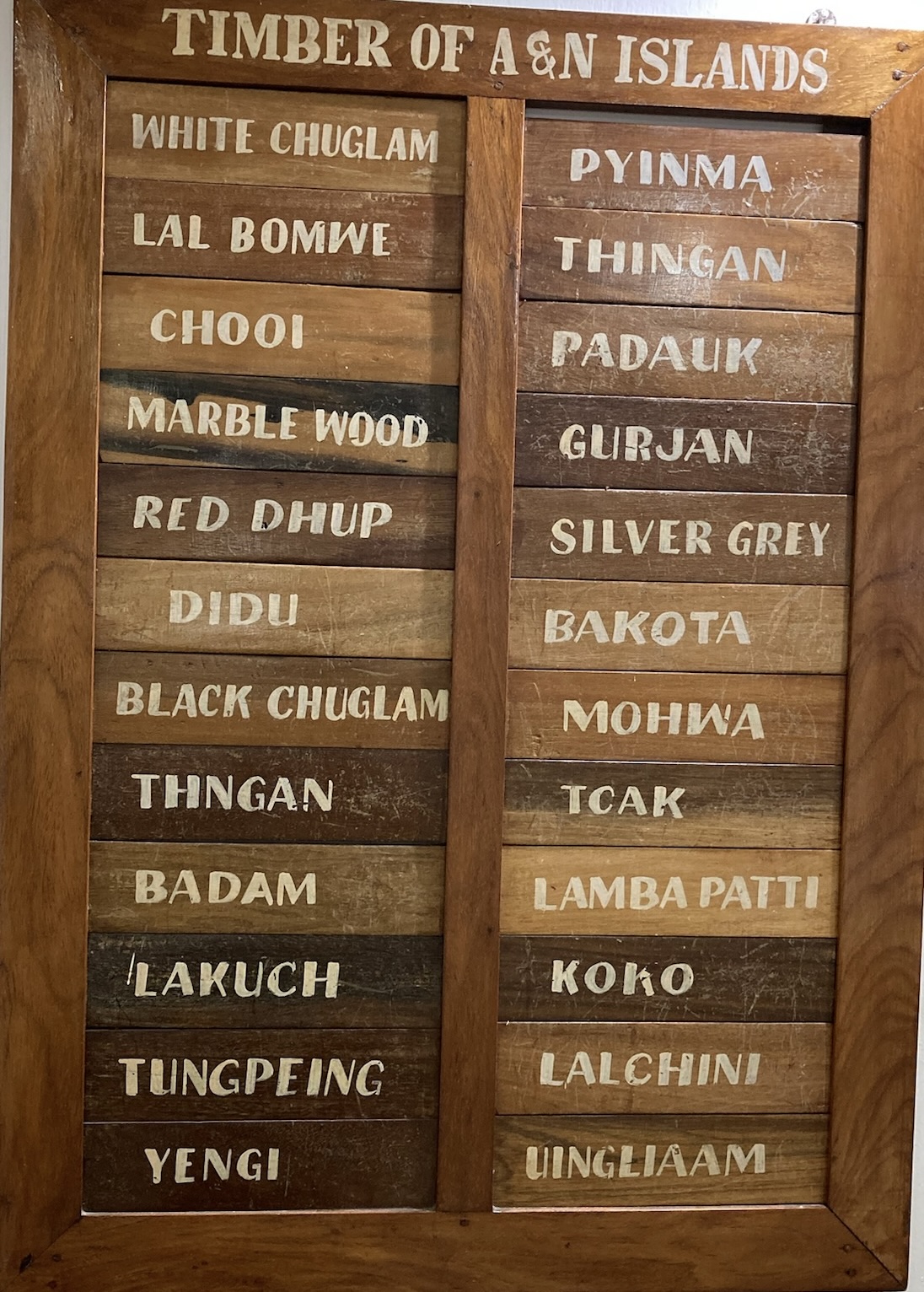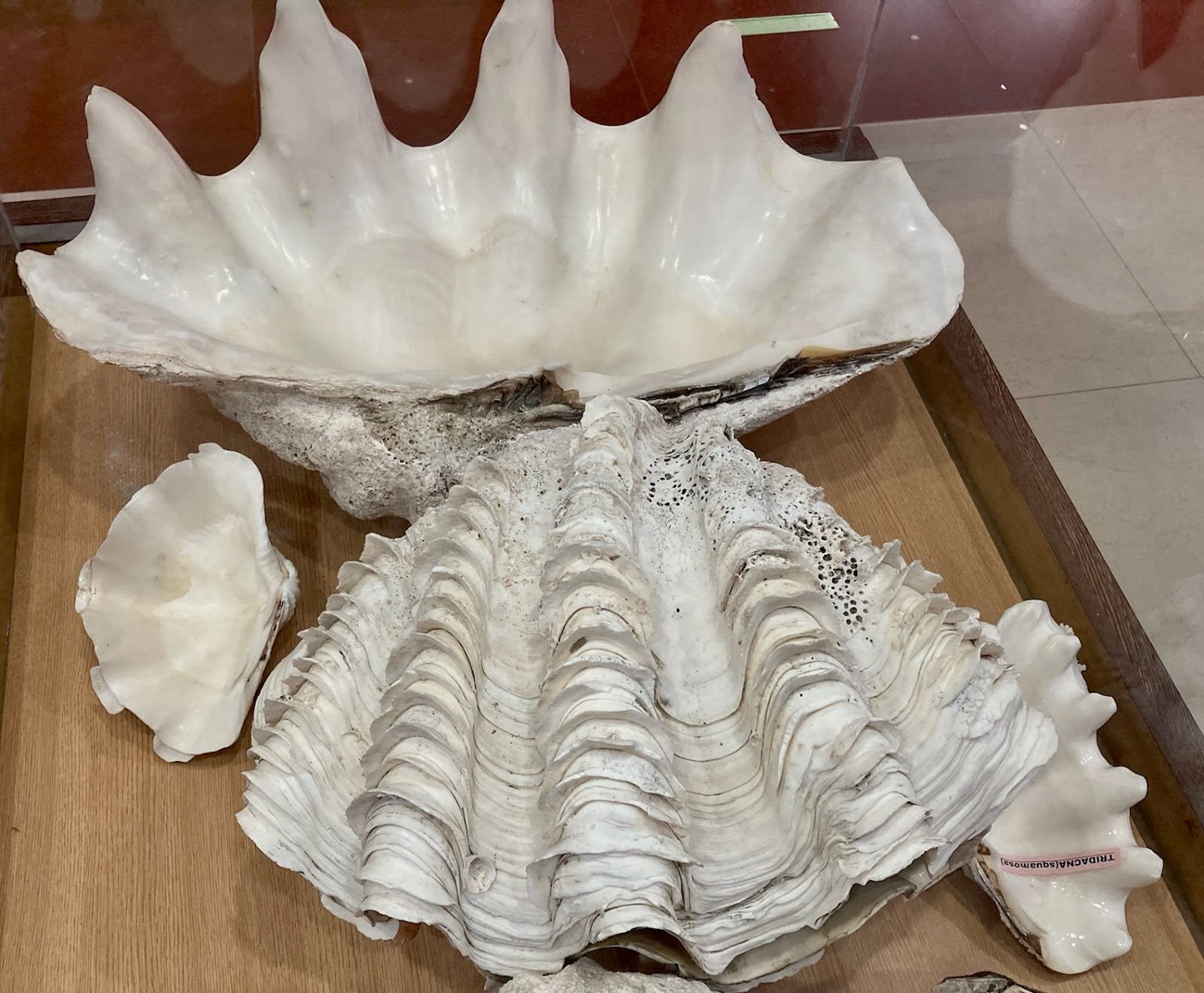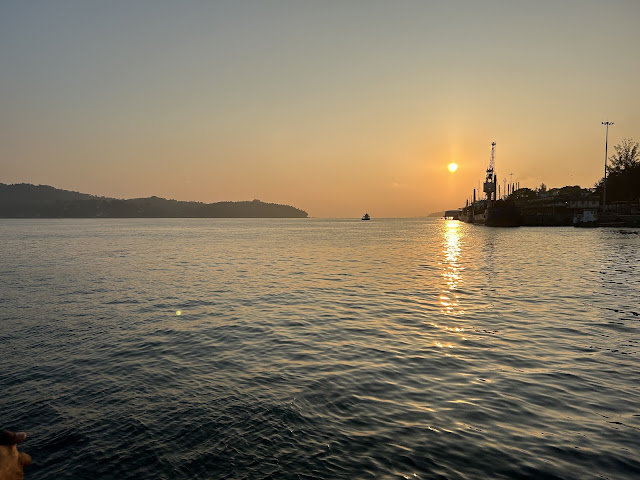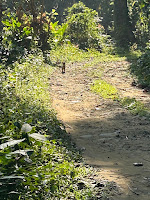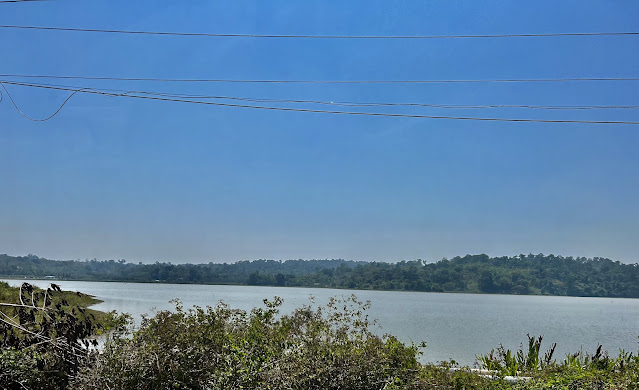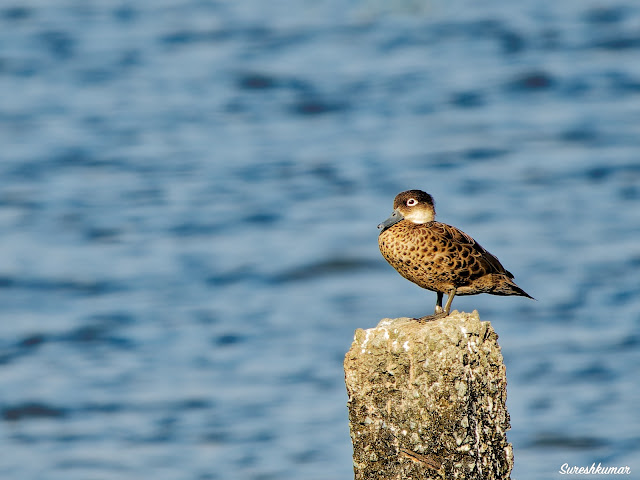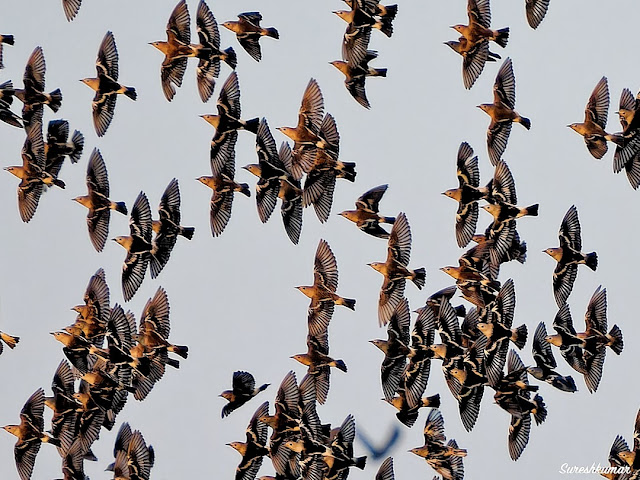Feb 15th 2024 - post lunch
Continued from here - the morning at Kalatang
The Samudrika museum is in Haddo. It was less than 500 m from where we stayed.
Andaman Nicobar archipelago is situated in the Bay of Bengal, mid way between peninsular India and Myanmar, spreading like a broken necklace in the North-south direction. These islands are Located between 06°45" and 13°41" North latitude, and 92°12" and 93957" East longitude. There are 572 islands which can be distinguished into two groups geographically. Only 36 islands are inhabited by human beings, 24 being in Andaman group and 12 in Nicobar group of islands. Islands located north of 10° A latitude are known as Andaman group of Islands while islands located south of 10°N latitude are called Nicobar group of islands: Total geographic area of A L I Islands is 8249 sq km of which Andaman group of islands cover 6408 sq km. while Nicobar group cover 1841 km.
These islands are the summits of a submarine mountain range bring on the great tectonic suture zone extending from the eastern Himalayas along the Myanmar border to the Arakan and finally Sumatra and lesser Sundas. The northern most part of these islands is isolated from Cape Negrais in Southern Myanmar by the North Preparis Channel and the southern most part is also separated from the Acheen Head of Western Sumatra by the great Channel. There are two more deep channels - the Ten Degree Channel which isolates Andaman islands from Nicobar islands and the Somber Channel which isolates great Nicobar from Nicobar Is and the Nancowrie group.
FORMATION OF ANDAMAN AND NICOBAR ISLANDS
Far back in time, some 150 million years ago, molten magma might have oozed from earth's crust along the dilated ocean floor at the foot of a submarine ridge. The phenomenon appears to have taken a long time thus creating mid-ocean rise known to many Geologists as. 'whale back tumours. These islands with a few exceptions are volcanic in origin. We are in fact at the tip of a risen undulating lava plateau, the core of which goes deep down beyond the ocean floor. This hypothesis is in conformity with the expanding earth theory.
The only live volcano in the Indian peninsula, Barren lies around 120 km. North East of Port Blair in Andaman sea (12°17' North Latitude and 93•50' East Longitude. This tiny almost circular island covers an area of about 8 sq. km and has a diameter of about 3 km. It belongs to general Sunda group and is believed to have born out of an eruption which occurred during the late Pleistocene period. Later in the course of geological evolution the prime giant cone got transformed to the present day Barren. The existing cone in fact, is the central part of the blown off cauldron.
Contrary to its name Barren Island is fully covered with lush green forest and is inhabited by 13 species of birds, 10 species of butterflies, 09 species of insects, 07 species of mammals, 06 species of flies and 02 species each of centipedes and spiders. The mammals include a stock of feral goats, which have adapted themselves to the terrain and depend on sea water to survive in the absence of a perennial fresh water source on the island. It is believed that the goats reached the island following a shipwreck in the region.
(Barren Island sounds totally fascinating!Erupted in 1991 and then even in 2020! https://roundglasssustain.com/photo-stories/barren-island)
DISCOVERY
The Chinese knew of these islands more than a thousand years ago and called it 'yeng-t omag' in the first millennium. Ptolemy, the renowned Roman geographer during the second century called it "Angdaman islands '(Islands of good fortune).
I' T Sing, a Buddhist monk, named it Lo-jen-kuo' (Land of Naked). The great traveller Marco Polo called it 'Angamanain. In the 15* century, Nicolo Contri, the Italian traveler called them 'Island of God".
However, when the current name 'Andaman' crept in is shrouded. The Indian legends trace back the origins of the islands to antiquity. The name Andaman being derived from Handuman, or Hanuman, the monkey god of the epic Ramayana, who is said to have used the islands as stepping stones on his journey to Sri Lanka across the sea. The name Nicobar seems to be a corruption of a South Indian term Nakkavaram' (Land of Naked) as indicated in the great Tanjore inscription of 1050 A.D.
ABORIGINES & TRIBES
It is believed that the Andaman aborigines might have reached these islands very early in time, possibly by boat from South East Asia since they show a strong affinity to the Semangs of Malaysia and the Aetas of Philippines. However, a recent DNA match is indicative of direct link with the pygmies of Southern Africa. The Nicobarese must have migrated sometime before the Christian era.
The origin of Andaman aborigines are primarily hunter-gatherers, whereas the tribes of Nicobar are mainly horticulturists and herders. Sentinelese continue to be hostile to outsiders whereas the once ferocious Jarawas are gradually becoming friendly to civilized population. Onges and Great Andamanese have accepted the presence of outsiders. The Nicobarese have integrated well with outsiders and have joined the Indian mainstream. Shompens still avoid contact but are non hostile.
 |
JARAWA
This Jarawas live in the reserve forest belt of about 639 sq.km area in western coast of south and Middle Andaman. The members of this tribe are now becoming frienaly. However, they continue with their primitive way of ife. The Jarawa live in communal huts, which lack a sleeping platform. They utilize naturally available material such a palm laves, barks, canes, seashells, corals etc. for their ornaments as well as for their dress. Their population is around 240.
ONGE
The Onge live in Little Andaman, as island 130 km. south of Port Blair. They inhabited in two settlements, one at Dugong Creek and other at South Bay overan area of 25 sq. km. The Onge differ from the Great Andamanese in language and in some aspects of their culture. Their settlement pattern and subsistence activities are however similar to those of the Great Andamanese. They have their local groups with well defined territories for hunting and collecting forest products.
Each member of the clan lives in his / her respective communal hut. This tribe still exists as hunters. Monogamy is their traditional social norm. Ones are friendly with neighbours and visitors. There are about 98 Onges alive today.
GREAT ANDAMANESE
The vanishing Great Andamanese tribe is settled at Strait Island, which is about 46Km. Away from Port Blair and has an area of 60ha. Present population of 43 are the remnants of ten clans of the once flourishing aborigines who inhabited the South & Middle Andaman and were first to be befriended. Mass mortality occurred among them soon on contact with civilized man through influenza, small pox, measles and sexually transmitted infectious diseases. Today they are considered perhaps the weakest ethnic group.
NICOBARESE
Nicobarese are simple people and maintain a simple lifestyle. A 'Captain' heads each village and the leader of the whole island is known as the 'Chief Captain'. Central Nicobar Islands were sometimes headed by lady captains often termed as 'Rani' of the island. Rani Lachmi of Nancowry and Rani Changa of Katchal ruled their respective islands with authority for a considerable period. The Nicobarese joined mainstream civilization a couple of decades back and boasts of employment in respected civil posts and private endeavours by their clan. Their present population is estimated at 28653.
SENTINELESE
Sentinelese are the sole inhabitants of the North Sentinel Island, which is 60 sq.km in area and located 34 km west of South Andaman. They live in complete isolation. They are hostile, semi -nomadic and their settlement consists of about 20 single huts close to one another in a cluster. Their present population is estimated at 39.
SHOMPENS
The Shompens inhabit 119 sq. km interior forest area of Great Nicobar. They are shy by nature and avoid contact with outsiders. Shompens live invariably along or around the perennial fresh water rivers, streams or rivulets in the forest. Shompen villages generally comprise 2 to 10 huts at a place. Their huts are constructed on piles, the height of which varies from. 1.5m to 3m. they use palm leaves and padanus leaves to thatch their huts. The floor space on the piers is used for living while the space below is utilized for their domestic animals. Monogamy as well as polygamy is a social norm. In each village the oldest male is the head of the tribe. Burial is their traditional custom fordisposal ofthe dead. Shompen population is estimated to be 398.
NATURAL ECOSYSTEM & WIDUFE
Andaman I Nicobar Islands with its vast coastline of 6 lakh sq. km. of exclusive economic zone and richest rain forests are the repository of an immense variety of ecosystems and wildlife. There are over 2200 flowering plants and 120 ferns (Gesides other plants), 58 mammals, 242 birds, 83 reptiles, 10 amphibians, 750 fishes, 326 coelenterates (corals, sponges, sea anemones, jellyfish etc), 407 crustaceans (crabs, lobsters, shrimps, barnacles, etc), 941 molluscs (limpets, oysters, clams, snails, squid, mussels, etc) 1500 insects, 62 spiders and scorpions, and others.
The biological investigation is a continual process and possibly many more species will be unearthed over time.
It is significant to note that a high percentage of these species and sub species are endemic. This is largely because of the isolated nature of the islands where there is always a great tendency for speciation among the island animals.
The flora and fauna of these islands have varied similarity or affinity to the of Indo-Chinese, Indo-Malaya, Indo-Burmese and Indian mainland regions.
TIMBER
(My heart wept at this title - living trees and forests, and all we can see is there use as timber.)
Andaman Forest abounds in plethora of timber species numbering 200 or more, out of which about 30 varieties are considered to be commercial. Major commercial timber species are Gurjan (Dipterocarpus spp.) and Padauk (Sterocarpus dalbergioides).
Ornamental wood such as Marble wood (Diospyros marmorata), Padauk (Pterocarpus dalbergioides), Silver grey (a special formation of wood in white chuglam), Chooi (Sageraca elliptica) and Koko (Albizzia Lebbeck) are noted for their pronounced grain formation.
Burr and the Buttress formation in Andaman Padauk are World famous for their exceptionally unique charm and figuring. Largest piece of Buttress known from Andaman was dining table of 13' X 7'.
The largest piece of Burr was again a dining table to seat eight persons at a time.
ARE CORAL ANIMALS OR ROCKS?
Many people think that corals are just lifeless rocks but in fact corals are animals which grow in stony skeleton. The living part of a coral is a thin layer on the outside of the colony. The coral animals can withdraw into the skeleton when they are attacked or when they are just resting. Coral animal is called a polyp and is a small, soft tube which looks like a tiny tree with its branches swaying in the water. At the top of the polyp is the mouth which is surrounded by the finger-like branches called tentacles. The polyp nestles inside a porous cup like structure.
Corals are found in different shapes and sizes. In this photograph (taken at night) the colonies of polyps can be clearly seen to emerge and extend their tentacles to extract calcium from seawater to build their communal coral reef structure, and use their stinging nematocysts to capture tiny zooplankton delivered by marine currents.
Coral Reef
A coral reef is an assemblage of more than 3,000 living organism in perfect harmony, a magnificent manitestation of nature's ability to create, thread and balance various life forms in space and time. Coral reef ecosystem is the most intricate, diversified and aesthetically appealing ecosystems of this planet.
Andaman Reef Builders
Coral reef all over the world are the handiwork of Hermatypic reef builders. In these islands there are two chief reef builders namely Porites and Favia. The other forms present here such as farites, platygyra, symphyllia, ganiasprea and diplostrea (brain coral) are the associated reef builders. These coral create massive dome shape colonies creating shelters for other branching and delicate forms such as Acropora (Staghorn coral) Pocillopora (Thorny coral), Stylophora (Birds nest) and Montipora to establish.
All the massive and branching forms named above are sedentary and colonial. However, there is also a solitary coral, which belongs to family Fungidae popularly known as. 'Mushroom Coral'.Coral Reproduction
A true reef building stony coral may be unisexual or bisexual.
In sexual process they breed together once in a year at a predetermined time after dusk, a day or two before the spring full moon. Male and Female spawn is released in millions of pink balls. These balls burst and the process of fertilization is completed. This process, at places, is so intense that the water stays pinkish till next morning. A large number of baby corals are released in the open ocean this way. After sometime these baby corals settle over a suitable substratum and start forming new colonies through asexual reproduction. Their morphological features change with environment in which they settle.
 |
| I saw these corals on the snorkelling outing from Chidiyatapu, the next day. |
The museum had a great shell collection
There was another section on the achievements of the Indian Navy and their presence in the Andamans. It was getting to closing time, and so we left. I strolled past the humongous Blue Whale skeleton that was kept on the lawns in the front.
 |
| As we strolled back, this elegant mosque caught my eye. |
 |
| One of the beautifully decorated minarets. |
As the sun went down, there was another surprise pre dinner. Jabili showed us the Andaman Masked Owl sitting in near darkness under the roof eave of one of the homes!


